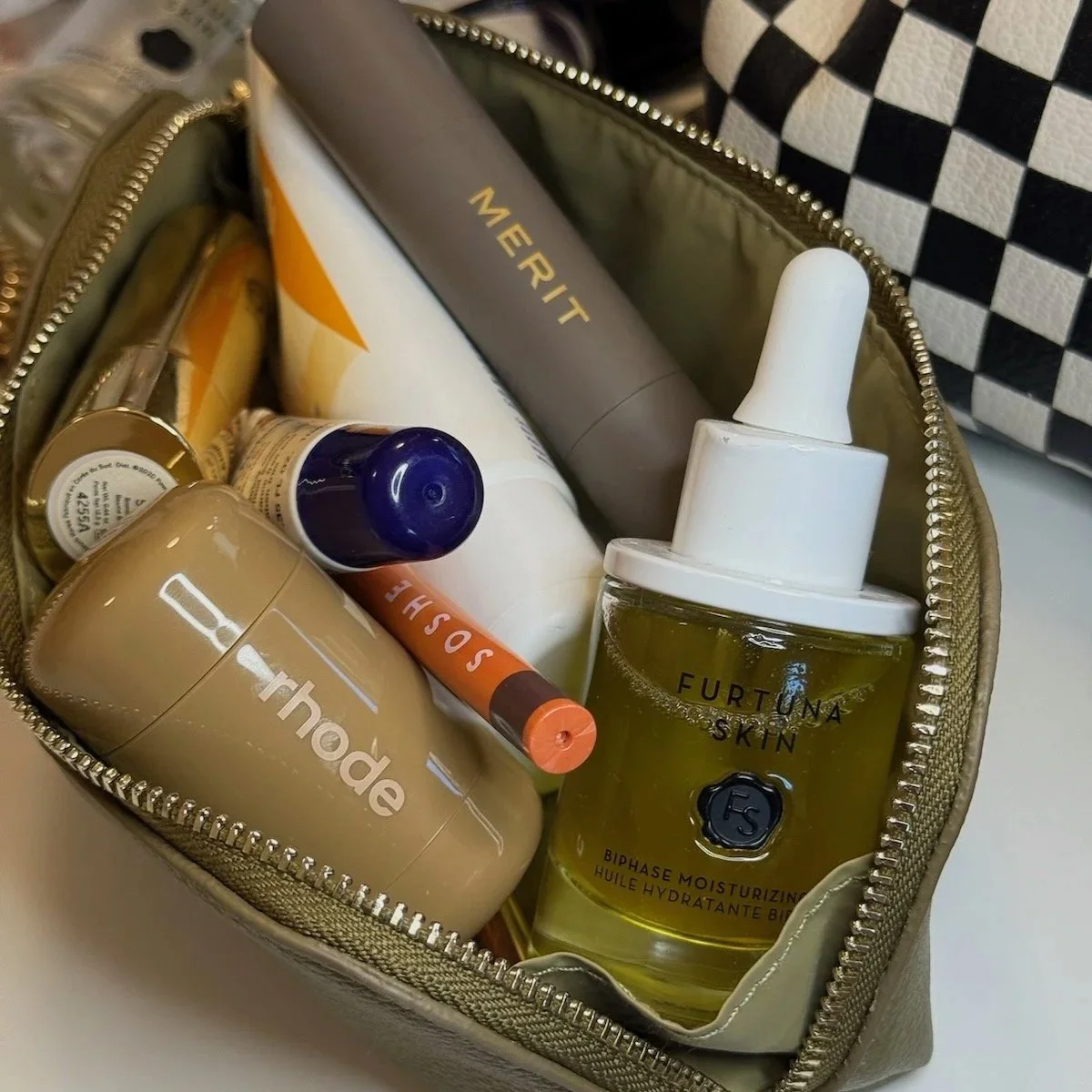Let's Talk About Melasma For A Quick Sec
by Marissa Pomerance
If ever you’ve wondered “what in the hell are these blotchy, dark, discolored patches taking over my face?” then like 6 million other American women, you might have to add “melasma” to your growing laundry list of skin-related complaints.
Melasma is a form of hyperpigmentation caused by sun exposure and/or hormonal fluctuations that leaves darkened patches on your skin.
But whether you’ve been battling melasma for years, or you’ve noticed your first little spot, treating it can be an incredibly difficult process. We wish we could give you one magical, easy and inexpensive hack that would clear your it up immediately and forever; but alas, we can’t.
So instead, we’ve compiled a list of the 5 things you MUST know about melasma, including how to prevent and treat it properly.
1. Prevention Is Everything. Truly.
We know you absolutely do NOT want to hear this, because you’ve heard it approx. 437 times, but when it comes to preventing melasma, you need to avoid the sun. Heat and UV rays create oxidative damage that boost melanin production, leading to melasma. According to Celeste Wilson, a Registered Nurse with a Bachelor of Science in Nursing, “the number one thing to avoid is SUN EXPOSURE. There’s just no getting around it with melasma—it’s the sun. You need to stay out of the sun.”
She also recommends topical products with skin-protecting ingredients, like antioxidants and Vitamin C’s, which defend your skin from environmental factors that create oxidative stress.
And of course, if you have to go outside (on those rare trips to the grocery store), you’ve got to use an SPF. According to Celeste, a physical SPF (instead of a chemical sunscreen), will provide the best protection, as “they use a physical barrier like Zinc Oxide to block rays.” A chemical sunscreen, which is usually made with ingredients like oxybenzone or avobenzone “creates a heat release on the surface of the skin, so that the UVA and UVB rays don’t touch the skin.” But since this heat reaction could potentially aggravate melasma, she recommends using a physical sunscreen as the best protection for melasma.
2. OTC Products Can Be Effective, But Require Patience
Celeste believes it IS possible to address and treat melasma with over-the-counter products, but you have to be a bit patient.
She recommends using products “to help slough off dead skin cells and increase cell turnover, which will eventually over time lift those deeper layers of melasma pigmentation.”
These include “AHA’s (alpha hydroxy acids), enzymes, and different chemical exfoliants. You shouldn’t use a super harsh physical scrub, but instead look for products that gently increase cell turnover and lift dead skin cells.” We love the Elemis Dynamic Resurfacing Peel Pads, which use lactic acid (an AHA) and enzymes to gently exfoliate without abrasively damaging the skin’s barrier.
If you think your skin can tolerate something stronger, Celeste suggests looking into a Retin-A, which is a chemical exfoliant that’s a bit more intense. You can find these at drugstores and department stores alike in smaller percentages, but “if you want a more intense chemical exfoliant, you can get a prescription for a Retin-A from a dermatologist.” However, she recommends approaching extra-strength Retin-A with extreme caution, as “it can make you more sensitive to sun exposure, which is the enemy of melasma.”
3. The Medical Treatments For Melasma Are Hideously Confusing.
Whether it’s lasers, chemical peels, or micro needling, it seems there are a lot of conflicting answers on the efficacy of in-office treatments for melasma. When choosing a treatment plan, the first thing you MUST do is talk with your dermatologist to be sure that what you have is actually melasma, and not another form of hyperpigmentation. Because while some forms of hyperpigmentation—like rosacea and dark spots-- respond beautifully to lasers like the Ruby or Fraxel laser, these more aggressive lasers can use too much heat and create an inflammatory response, potentially worsening melasma and hyperpigmentation.
And women with darker skin tones may need to proceed with even more caution, as some treatments can actually worsen their melasma. According to dermatologist Dr. S. Manjula Jegasothy, “lasers can only be used on melasma patients with lighter skin tones because they are less likely to develop hyperpigmention.” Instead, she prefers to use clinically-studied brightening creams and gentle peels on her clients with darker skin tones.
To get the details on professional treatments that may work for melasma, we spoke to Dr. Simon Ourian, a leading cosmetic surgeon at Epione in Beverly Hills. He explained that while “there is no one single cure for melasma, there are a number of treatments that can help get rid of melasma over time.”
Here are a few of the most effective options:
Coolaser: Dr. Ourian is the creator of the Coolaser, a technique in which he simultaneously cools the skin with a special device while using a series of light pulses to stimulate cell repair and collagen growth. He calls Coolaser “the gold standard for treating melasma,” but unfortunately, it’s only offered at the Epione office in Los Angeles.
LED Light Therapy: For those of you that don’t live in LA, Dr. Ourian recommends LED light therapy, a treatment commonly offered by dermatologists, aestheticians, and at-home devices. While red light therapy is known for reducing inflammation and encouraging collagen production, green light therapy discourages excess melanin production, which can help melasma.
Clear & Brilliant Laser: And if you’re still dying to try more commonly-offered laser treatments or peels to treat your melasma, the specialists at Ava MD suggest the Clear & Brilliant laser, which is a gentle laser that resurfaces the skin to minimize sun damage, brown spots, and uneven pigmentation. Clear & Brilliant is ideal because of its minimal side effects, and can be safe for darker skin tones.
Cosmelan Peel: Ava MD also recommends a Cosmelan Peel, which includes a chemical exfoliant and reparative recovery cream to gently reduce melasma and prevent melanin formation.
4. WTF Is Hydroquinone And Does It Work?
Hydroquinone is one of the oldest and most popular topical treatments for melasma. Some consider it the gold standard of treating melasma, especially in darker skin tones. Essentially, it’s a skin-lightening bleach that’s generally considered safe and effective by dermatologists, and it was approved in small percentages by the FDA.
However, some dermatologists and experts warn about hydroquinone misuse. Dr. Zein Obagi, a leading dermatologist and skincare expert, believes in the efficacy of hydroquinone when used under medical supervision. But he argues that overusing extra-strong hydroquinone can lead to worsening melasma and hyperpigmentation over time, as like strong lasers, hydroquinone can produce inflammation, leading to post-inflammatory hyperpigmentation. Plus, the bleaching effects of these products on the parts of skin not affected by melasma can actually make those parts with melasma look more pronounced in comparison.
Like anything else, make sure you’re working with a pro before buying some black market, 50% hydroquinone cream that you’ll slather all over your face for the next 23 years.
5. Beware of Skin-Lightening Internet Scams
Turns out, a lot of skin-lightening products are a total scam. Many melasma sufferers, in a bout of understandable frustration, turn to the dark corners of the internet for treatment, buying oral or injectable glutathione products. Currently, the FDA has not approved any injectable products for skin lightening or whitening. And the ones found online can be really dangerous and potentially harmful for your thyroid and kidneys. Even better? They’re mostly ineffective.
We know—treating melasma is profoundly frustrating. You’ll most likely run out of money and your time on this earth trying every treatment, tincture, and miracle cure you come across online. Or, you can do something entirely radical and you can try to accept that hyperpigmentation isn’t ugly or inherently dangerous to our well-being. Instead, let’s reframe this benign “issue” to be just another part of our body that changes over time. And change doesn’t always have to be as hideous as we think it is.
Annnnnd if that’s too woo-woo for you, we also wholly endorse trying out any of those powerful treatments listed above.
Marissa Pomerance is the Managing Editor of The Candidly. She’s a Los Angeles native and lover of all things food, style, beauty, and wellness. You can find more of her articles here.







